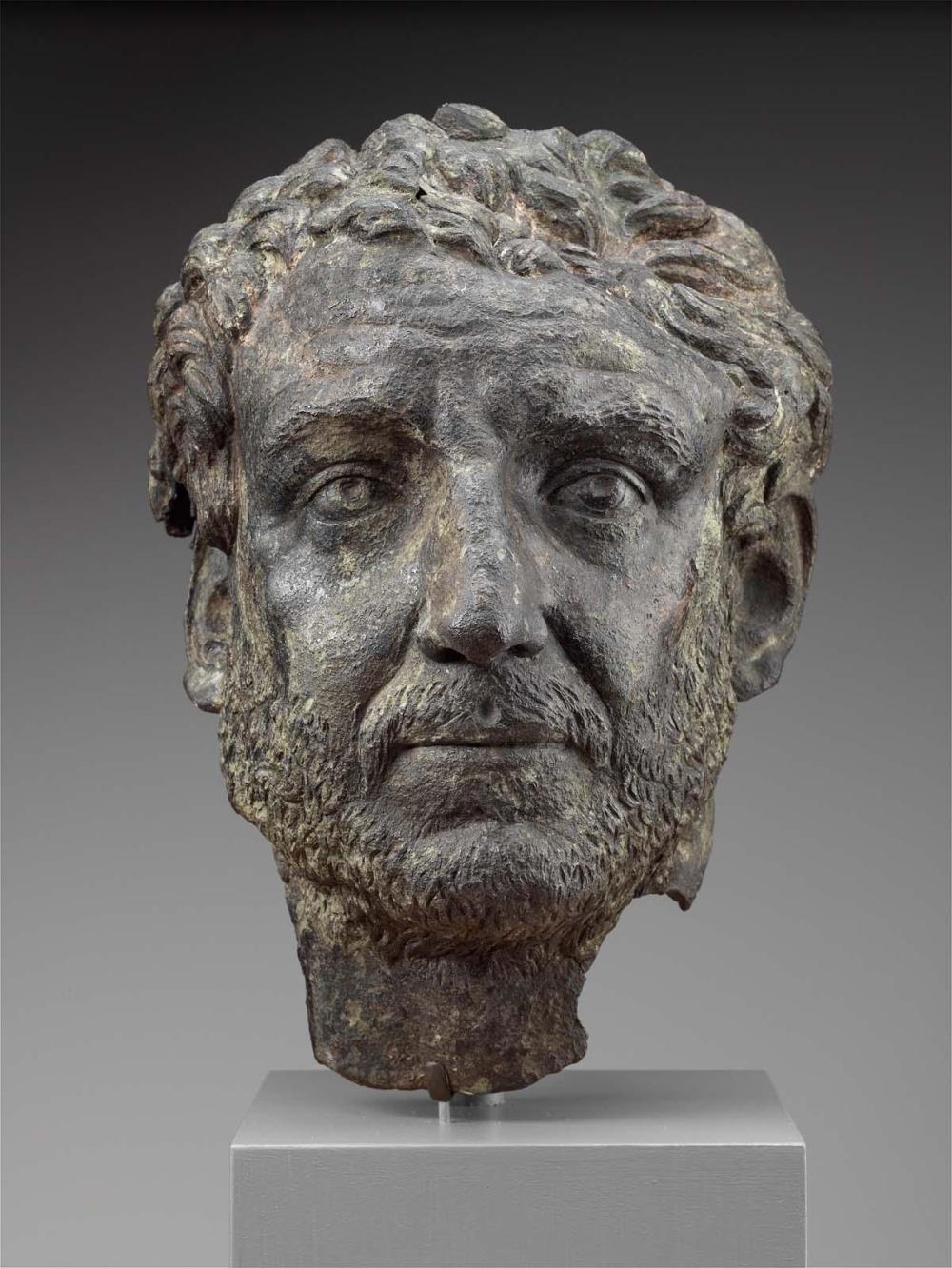Advanced Search
Head of a man
Roman
Imperial Period
A.D. 200–225
Medium/Technique
Bronze
Dimensions
Height: 31 cm (12 3/16 in.)
Credit Line
Catharine Page Perkins Fund
Accession Number96.703
CollectionsAncient Greece and Rome
ClassificationsSculpture
The honor of a public image was sometimes extended to Romans outside the imperial circle who distinguished themselves through public service or military success. This head of a now-anonymous man once belonged to a life-size bronze statue, one of the costliest types of honorific monument. Sunken eyes, a lined face, and a furrowed brow lend the portrait an air of mature gravity. The combination of short, thick, and curly hair with a closely cropped beard dates the work to the early third century A.D., when this style of grooming was in fashion. The incision of fine details, such as the strands of the eyebrows and the irises and pupils in the eyes, had long been a regular feature of large-scale portraits in bronze, though by this time the practice had spread to marble statuary as well.
This head is reported to have been found in 1878 in Rome, in a stretch of the Tiber River spanned today by the Ponte Sisto, a Renaissance bridge. Along with the head were recovered several other bronze statue parts, some architectural fragments, and an inscription recording the dedication of an arch to Valentinian I and Valens, brothers and co-emperors (reigned A.D. 364-75), around A.D. 367; the arch would have marked the entrance to an ancient bridge on the spot. A toga-clad statue incorporating this bronze head may have been reused more than a century after its creation as part of the arch's decorative program; the integration of recycled sculpture into new monuments was a common phenomenon, especially in late antiquity. The dent in the left side of the head and the irregular break at the neck may indicate that the arch was destroyed-perhaps in the eighth century, when the swollen river is thought to have inundated the bridge.
This head is reported to have been found in 1878 in Rome, in a stretch of the Tiber River spanned today by the Ponte Sisto, a Renaissance bridge. Along with the head were recovered several other bronze statue parts, some architectural fragments, and an inscription recording the dedication of an arch to Valentinian I and Valens, brothers and co-emperors (reigned A.D. 364-75), around A.D. 367; the arch would have marked the entrance to an ancient bridge on the spot. A toga-clad statue incorporating this bronze head may have been reused more than a century after its creation as part of the arch's decorative program; the integration of recycled sculpture into new monuments was a common phenomenon, especially in late antiquity. The dent in the left side of the head and the irregular break at the neck may indicate that the arch was destroyed-perhaps in the eighth century, when the swollen river is thought to have inundated the bridge.
Catalogue Raisonné
Greek, Etruscan, & Roman Bronzes (MFA), no. 175; Sculpture in Stone and Bronze (MFA), p. 121 (additional published references); Highlights: Classical Art (MFA), p. 178-179.
DescriptionHead of an unknown man. The face is rectangular in shape with a strong jawline, a broad and prominent nose, and a wide mouth with thin lips. The eyes are small and almond-shaped with thin lids, and the pupils are irises are rendered three-dimensionally. The gaze is directed up and away from the viewer. Deep naso-labial lines frame the mouth. There are wrinkles on the forehead and the brow is furrowed. The ears are large and the proper right ear is significantly lower than the left. The beard is cropped short and closely follows the shape of the jaw. The eyebrows are rendered plastically and gently arched. The hair is short and composed of loose curls.
The head is broken at the neck and the left side of the head (above the ear) has been pushed in, likely caused when the statue toppled in antiquity. There is a dark, greenish-black patina.
The head is broken at the neck and the left side of the head (above the ear) has been pushed in, likely caused when the statue toppled in antiquity. There is a dark, greenish-black patina.
ProvenanceAccording to Lanciani, Ruins and Excavations of Ancient Rome (1897), pp. 24-25, the head was found in the Tiber in 1878 and bought many years later by Alessandro Castellani; by date unknown: with Edward Perry Warren (according to Warren's records: Bought in Rome, said to have been found in Tiber) (MFA Bronze catalogue added the location of Ponte Sisto); purchased by MFA from Edward Perry Warren, October 1896




